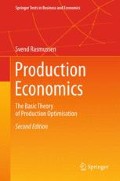Abstract
In the real world, no production is carried out using only one input. Normally, several (controllable) inputs are used. Hence, when growing cereal crops, land, seeds, labour, fertiliser, pesticides, machinery, etc. are used. A car manufacturer uses steel, labour, leather, plastic, paint, tyres, fuel, etc. Various inputs can often replace each other so that it is possible to replace some of the expensive ones with cheaper alternatives if the price of one input increases. For example, if the price of pesticides, which are used to chemically control weeds in the field, rises, then the use of labour might be considered as an alternative to control the weeds. If the price of fuel used for heating factory or office buildings increases, it may be cheaper to use electricity for heating instead. The question as to the extent to which the various inputs can replace each other becomes the key question in this connection. This chapter deals with the instruments which can be used to address such issues. As in Chap. 3, we assume competitive input and output markets.
Access this chapter
Tax calculation will be finalised at checkout
Purchases are for personal use only
Notes
- 1.
The non-competitive case is treated in Chap. 13.
- 2.
Please note in this connection that the expansion path as presented here is a stationary image as, in reality, the (relative) input prices are presumed to be constant, and the production function is presumed to be unchanged. In the real world, an expansion of production will take time (it takes e.g. time to build a new building), and when the expansion at a later point in time has actually been carried out, then the prices w 1 and w 2 might have changed, and the production function f(x 1, x 2) might also have changed due to the technological development.
References
Chambers, R. G. (1988). Applied production analysis: A dual approach. New York: Cambridge University Press.
Chiang, A. C. (1984). Fundamental methods of mathematical economics (3rd ed.). Singapore: McGraw-Hill Book Company.
Heady, E. O. (1952). Economics of Agricultural Production and Resource Use. New York: Prentice-Hall.
Author information
Authors and Affiliations
Corresponding author
Rights and permissions
Copyright information
© 2013 Springer-Verlag Berlin Heidelberg
About this chapter
Cite this chapter
Rasmussen, S. (2013). Production and Optimisation with Two or More Inputs. In: Production Economics. Springer Texts in Business and Economics. Springer, Berlin, Heidelberg. https://doi.org/10.1007/978-3-642-30200-8_4
Download citation
DOI: https://doi.org/10.1007/978-3-642-30200-8_4
Published:
Publisher Name: Springer, Berlin, Heidelberg
Print ISBN: 978-3-642-30199-5
Online ISBN: 978-3-642-30200-8
eBook Packages: Business and EconomicsEconomics and Finance (R0)

